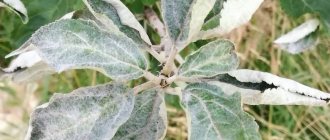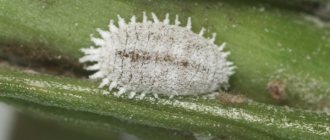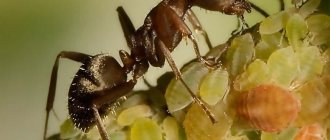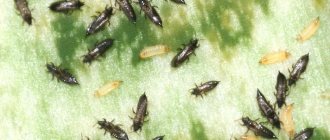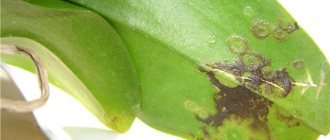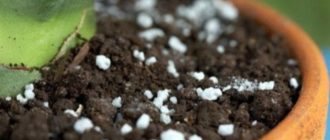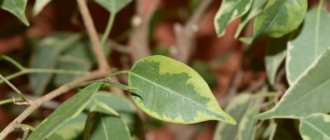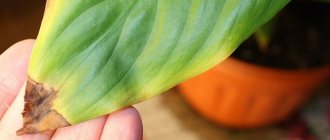0
When growing flowers at home, gardeners often encounter some difficulties, the most common of which is a white coating on the flowers themselves and in the pot. In order to approach treatment correctly, you need to understand the reasons for the appearance of plaque, of which there may be several.
The main reason for the development of diseases of indoor plants is the organization of improper care. As a result, favorable conditions are created for the life of parasitic insects, fungi and other diseases.
How to cure white bloom on indoor flowers? Causes and methods of control
When growing flowers at home, gardeners often encounter some difficulties, the most common of which is a white coating on the flowers themselves and in the pot.
In order to approach treatment correctly, you need to understand the reasons for the appearance of plaque, of which there may be several. The main reason for the development of diseases of indoor plants is the organization of improper care. As a result, favorable conditions are created for the life of parasitic insects, fungi and other diseases.
Healthy orchid root system: what it looks like, color, elasticity.
Roots are an indicator of the health of an orchid. Normally, they are dense, elastic, white or yellowish in color, and after watering they acquire a light green color. The color of the roots is determined by the type of orchid and often depends on the fertilizing applied.
Some species have naturally dark roots and this is not a manifestation of the disease. Inside the substrate, where sunlight does not penetrate, the roots may turn a light brown color.
Healthy roots.
White coating on indoor flowers: reasons
The most common cause of white plaque on the body of a plant and its leaves is damage to:
- powdery and downy mildew
- mealybugs
- mold
- gray rot
Therefore, it is necessary to understand the characteristics of each disease in order to choose the right drugs for treatment.
Powdery mildew
The leaves of indoor flowers quickly become covered with a white coating due to damage by mycelium - microscopic fungi. The disease is dangerous due to its speed of spread, and if urgent measures are not taken, the plants will soon die.
The disease is caused by the fungi “Sphaerothecarannosa”, the genus of which has many varieties. Therefore, any plant can become infected with powdery mildew.
A favorable environment for the development of this type of fungus is an increased level of humidity in the room, as well as sudden changes in temperature.
Fungal spores can easily migrate from one plant to another during watering, on the legs of insects and with air currents, so the disease is contagious. The infected plant is isolated and preventive treatments are carried out on all flowers.
The development of powdery mildew can be caused by excessive fertilizing with nitrogen fertilizers and calcium deficiency in combination with high temperature and humidity in the room.
Downy mildew
This is a disease related to powdery mildew, so the causes of their occurrence are identical, but the manifestations are significantly different. When affected by powdery mildew, a white fluffy coating formed by the mycelium spreads along the outer side of the leaf blade.
With downy mildew, the plaque is concentrated on the inside of the leaves, and their surface is covered with yellowish spots with a whitish coating that has a purple tint.
Mealybugs
These are parasites, as a result of whose vital activity a white sticky coating, similar in structure to cotton wool, is formed on the leaves and stems of plants. These insects settle on the inside of the leaves and feed on the sap of the plant, which leads to its death.
Mold
The formation of mold spots on the leaves is the result of infection by fungi - botrytis and mycelium. Mold appears as fibrous or fleecy substances covered in dust.
The disease is the result of frequent spraying of flowers, which results in the formation of excess moisture, which is a favorable environment for the development of fungi.
Mold must be combated, otherwise the process of rotting will begin and the plant will die.
Gray rot
Fragmented spots of white plaque with a gray tint are initially concentrated on the stems and leaf petioles. But the disease quickly spreads throughout the plant. Therefore, you need to be extremely careful so that gray rot does not destroy all your home greens, because there is no cure for this disease.
All these diseases are contagious and are caused by improper care, and in particular, increased levels of humidity and temperature.
Prevention is easier than cure
Fixing a problem is always more difficult than preventing it. Following simple rules saves time and allows you to grow indoor flowers healthy and beautiful.
- Do not water flowers with tap water. It needs to be defended, and for prevention it is sometimes recommended to soften it with citric acid.
- Do not overfill and watch the drainage holes so that they do not become clogged.
- Keep the container with the plant away from heating devices, spray and humidify the air in the room more often.
- The volume of the pot should be selected according to the size of the flower.
- To prevent fungal diseases, activated carbon is used once a month. A good disinfectant is a weak solution of potassium permanganate, which can be used for irrigation instead of ordinary water.
- In winter, fertilizing with fertilizers should be stopped, and loosening the soil will only be beneficial.
Prevention
To prevent the appearance of white plaque on the soil in pots, you should:
- Regularly loosen the top layer, especially after heavy watering.
- Once every two weeks, water the plant with a small amount of a weak solution of potassium permanganate (potassium permanganate).
- It is better to dry out the soil than to over-wet it. Overwatering is the main cause of mold.
- If the soil is very oily, you can add a little sand to it to make it less dense.
- Sunbathing will be a good preventative measure. If the plant tolerates sunlight well, it is better to keep it on the windowsill.
- If the water is hard, you can add a little lemon juice to it. Half a teaspoon per 1 liter of water is enough. An alternative would be to let the water sit for 24 hours.
- It is necessary to provide the plant with normal drainage. Below, under the layer of earth, you need to lay about 2 cm of expanded clay or small crushed stone. Also, the pot must have drainage holes. Otherwise, moisture will stagnate.
Getting rid of white plaque is quite simple. Folk remedies usually help. If there are not enough of them, you can use store-bought ones. But it is best to transplant the flower into a new container with fresh soil.
Treatment of different types of white plaque
In most cases, a white coating on the leaves and soil is a signal that the plant is not maintained correctly. Therefore, it is necessary to change these conditions to the correct ones, and, if necessary, begin immediate treatment of the flower.
How to get rid of mold?
An algorithm for certain actions is required here:
- if mold appears only on the top layer of soil, then you can simply remove it by collecting it with a spoon;
- if there is a need for replanting, the roots of the extracted plant should be washed, dried and only then replanted into new soil;
- after these operations, it is recommended to sprinkle the soil with soda or cinnamon;
- If mold appears on the leaves, they should be wiped with damp paper napkins.
It is better to perform the procedure outside in bright sunlight, if the air temperature allows. After treatment, the flower must be sprayed with fungicides.
It is better to cut off such affected leaves and discard them. It is very difficult to remove active mold that has penetrated the inside of the leaf.
What to do if it looks like cotton wool?
Cotton wool is a sign of the presence of mealybugs. To get rid of this parasite, you don’t have to run to the store for chemicals. There are quite effective folk methods.
- Brew calendula powder (sold in a pharmacy) like tea, cool and treat the plant with it (per 100 g of powder - 1 liter of water);
- chop the garlic, pour boiling water over it and let it brew for 3-4 hours, apply to the leaves using a sponge;
- Dilute 1 tablespoon of olive oil in 0.5 liters of water and spray with a spray bottle.
If the above procedures do not help, it means that the lesion has eaten deep. Then you will have to use chemicals.
The following drugs help well against scale insects:
- Decis;
- Bi-58;
- Fitoverm;
- Tsvetofos.
Leaf hygiene
The impeccable appearance of a plant indicates, first of all, that it is healthy. But sometimes even a healthy plant looks untidy, and the reason for this may be dust settled on the leaves.
Any housewife knows how quickly dust accumulates in a room, so regular cleaning is a routine but necessary procedure. Dust settled on the leaves of plants, when water gets on them, turns into dirt, which must also be removed regularly: dust and dirt interfere with the process of photosynthesis and evaporation of moisture, attract pests and create favorable conditions for the development of diseases .
Procedure for cleaning leaves:
- wipe the leaf plates once or twice a week with a soft material - a damp cloth or sponge;
- You need to remove dust from both the top and bottom sides of the leaves;
- Carry out the procedure in the morning or afternoon so that the leaves have time to dry by evening;
- very dusty or dirty leaves can be washed with soapy water, which should then be rinsed off with clean water. If you use alkali to wash the leaves, cover the substrate with film.
Leaves covered with fluff or lint are not washed, but are cleaned of dust with a brush with soft, thick bristles.
Using a vitamin cocktail
You can improve your orchid’s health by spraying the leaves with a vitamin cocktail. It is prepared from a mixture of vitamins :
- IN 1;
- AT 6;
- B12 (one ampoule of each);
- Dissolved in 1 liter of water.
It is enough to spray the orchid leaves once or twice a month with this composition
Indoor air humidity
Sometimes the tips of the leaves dry out, and dark brown spots form on the leaf blades. The reason for this is that the air in the room is too dry, and many decorative foliage plants require high humidity. What can be done to prevent the leaves from losing their attractiveness? Here are some ways to make dry air more humid:
- Small containers with water are placed between the plants, which, evaporating, saturates the air with moisture;
- pots with plants are placed on pallets with wet expanded clay or pebbles;
- the leaves are regularly wiped with a damp sponge and from time to time the moisture-loving plants are washed in the shower;
- in winter, when the air in the room is dried out by the heating operating at full power, barely wrung out wet towels are thrown over the radiators;
- The easiest way to increase the humidity level in a room is with a household electric humidifier.
Shower for ficus
Ficus is a living organism, and it also loves to swim. But if large-leaved ficus can still be dealt with manually, then plants with small leaves (ficus Benjamin, fern, dracaena, etc.) are much more difficult to clean. A shower, which many houseplants love, will help here.
When arranging a bath for your green friends, you need to protect the soil from washing out (with film or cloth), monitor the water pressure, which should be very small, and its temperature – no more than 30 degrees. If the ficus is very dirty, then you can use a weak solution of shampoo or baby soap, only after cleansing you need to thoroughly rinse them off the leaves.
A clean and healthy plant is the best decoration for your home interior. We hope that the little tricks you can use to wipe your ficus to make the leaves shine will be useful to you in practice.
Traditional methods
The principle of operation of home control methods is that plants are treated with emulsions, tinctures and substances that are supposed to remove shield aphids. Some of them have questionable effects, because sometimes they do more harm than good. After processing with onions, garlic, kerosene and alcohol, a burn is quite possible.
Oil emulsions and other similar substances form a film on the leaves that blocks the access of oxygen. At the same time, plants stop “breathing,” and photosynthesis, which they need to produce organic substances that promote growth and development, stops. Scale insects, as a rule, settle under the leaf where the stomata are located.
Soap-based solutions and tobacco tincture have shown positive results in combination with mechanical removal. Accordingly, they need to be used many times. The soap solution also forms an impermeable film on the leaves, so it must be washed off after 24 hours.
The most common folk mixtures:
- Baby soap : 1 liter of water, 1.5 tsp. grated cosmetic product. The solution is applied to large-leaved plants using a sponge, cotton wool or cloth. Stand for 15 minutes. And it is washed off with a shower (the ground must be protected from water).
- Kerosene-soap mixture : 10 g of kerosene, 50 g of laundry soap, 2 crystals of manganese. Apply the solution to places where insects accumulate with a cotton swab, cloth or brush. Leave for 30 minutes, rinse.
- Hot pepper infusion : 4 medium chilies, 500 ml water. Cut the pods, boil for 20 minutes, cool, strain, spray. Each time the broth is prepared fresh.
- Garlic (onion) infusion : 5 cloves of garlic or 1 medium onion. Chop the vegetables and add 150 ml of water. Leave for at least 5 hours, add 1 tsp. grated soap, apply using a sprayer.
- Infusion of walnut leaves : take 300 g of crushed raw materials, 1 liter of boiling water. Leave for 24 hours, treat the leaf blades of the plant on both sides after preliminary washing with soap, leave for 24 hours and rinse. For a stronger effect, you can add another 150 g of tobacco leaves to the tincture.
- Soap and alcohol solution : mix 1 liter of water, 10 ml of ethylene, 15 g of soap. Use carefully on plants with soft or thin leaves, as they are extremely sensitive to alcohol. The resulting mixture is applied with a brush first to one leaf and left for about a day. Only after a successful reaction to this test can further processing of the entire plant be carried out carefully.
This is interesting: Proper pruning of yucca at home - how to properly trim and form a bush
Olive oil
You can wipe the leaves with olive oil. It is necessary to apply it to a cloth or sponge and treat the plate from base to tip. Excess must be removed by blotting the leaves with a dry and clean napkin.
Before using the oil, you need to take into account that it will create a film on the surface of the plant, due to which the flower may stop absorbing moisture. In addition, this will make it difficult for oxygen to reach the leaves, which will affect development.
Milk
Milk is also used to add shine - you need to make a mixture by combining the drink in equal parts with water. After this, the resulting liquid is applied to a sponge and the leaves are wiped with it. The shine is not strong, but noticeable.
The solution may leave a film on some plates, as is the case with olive oil. Therefore, it is recommended to increase the amount of water, and, on the contrary, reduce the volume of milk. Then you will get a lighter product that will be safe for the flower.
If a solution with a lower concentration of milk is used, the shine will also be reduced. However, it can be neglected so that the development of pets does not stop for the sake of aesthetic appeal alone.
Beer
It is recommended to use beer for large plates. In addition, it is better to take a product with a short shelf life. For the solution you need to prepare 1 part beer and 1 part water, apply it to a sponge and wipe the surface. It will become smooth and dark green.
It should be noted that in the spring and summer, such a mixture will attract midges due to the taste characteristics of the beer and its smell. Therefore, it is better to use this method in winter or autumn, when there are few or no insects.
Vinegar
This substance is often used to add shine. It is necessary to dilute 1 part vinegar and 3 parts water, as in the previous methods, apply the resulting liquid to a sponge and wipe the plates. It is better to get rid of the remaining part of the solution, as it spreads unpleasant odors.
The proportions must be strictly observed, otherwise the plants may be damaged. So, yellow spots may appear on them, and the shoots may become deformed.
Egg yolk
The use of egg yolk is the most popular option; most gardeners use it. The yolk is applied to a brush, with which you need to rub the leaf until it shines. Excess product can be removed with a paper towel or napkin.
Just like in the situation with beer, it is better not to use the yolk in the summer, as its smell can attract insects.
How to deal with plaque
But this procedure is not always possible to perform immediately. In this case, you can do the following:
- Remove about two centimeters of the top layer of soil so that the mold and root system do not come into contact.
- Bring the watering regime back to normal and avoid over-moistening the soil.
- If the soil is heavy and dense, it should be loosened carefully. This will help remove excess water and normalize gas exchange.
If using these methods it is not possible to remove the white plaque, then you can use folk or store-bought remedies to combat mold.
Folk remedies
If the focus of infection is small, and the white coating appeared not so long ago, then you do not need to use strong chemicals.
a solution of citric acid is often used to cultivate land . Take 2-3 grams per glass of water. This product can be watered no more than twice a month. It can be used for plants that can grow in acidic soil.
You can also use regular garlic . To do this, make an infusion or bury several cloves around the flower. During watering, phytoncides will enter the soil, which prevent the spread of pathogens.
Wood ash can also disinfect the soil. It also quickly removes excess moisture from the soil. Depending on its capacity, take from 30 to 100 grams of ash per pot. It is sprinkled around the flower and mixed with the top layer of soil. It is important not to touch the roots of the plant.
Purchased funds
To combat white plaque, the following drugs are used:
- Sarfun 500 sc . Produced in the form of a concentrated suspension. This is a broad-spectrum fungicide that has a therapeutic effect. The plant and soil surface are sprayed with it.
It is best to do this during the growing season. The drug is also used to prevent the appearance of mold on the ground.
Protects the flower for a month and is not washed off when spraying the leaves. Destroys the fungus in about a day.
It is recommended to perform the procedure in the morning or evening. When processing the plant, it is important to ensure that the drug does not get into your eyes. Topsin M. This is a systemic contact fungicide that is used to treat and prevent fungal infections. In addition, it copes well with parasites.
The main active ingredient is topsin. Produced in the form of an emulsion or powder. Has a beneficial effect on shoots. After treatment, the flower begins to develop better. The action begins on the first day after treatment. The procedure is repeated after 2 weeks.
Azophos . One of the most effective drugs. Quickly suppresses the development of fungus, and also provides nutrition to the flower, nourishes it and promotes growth.
Its action is similar to Bordeaux mixture, since the drug destroys fungal spores.
Powdery mildew is a disease caused by ectoparasitic microscopic fungi; it can develop not only on the leaves, but also on the fruits of some plants, as well as on the above-ground parts of the shoots.
To identify the problem, you can conduct a small experiment - try rubbing the area that was affected by the disease. If it really is powdery mildew, small pellets appear on your fingers; they will consist of mycelium threads, and very small ones at that. Gardeners advise fighting this fungus with drugs - fungicides developed on a sulfur basis.
Preventive measures at home
Any disease is easier to prevent than to treat. The same applies to indoor flowers. Preventive measures should not be carried out daily, but regularly.
Periodic soil replacement
It is carried out like this:
- The plant must be replanted approximately every three years to improve growth. During transplantation, inspect the soil and roots. If fungus and mold are detected, it is better to replace the soil completely;
- It is recommended to change the top layer of soil once every 3 months;
- the procedure can be carried out at any time of the year, except winter.
It is believed that large indoor plants need to replace the soil more often. They develop a root system faster, which, as it grows, becomes more vulnerable to diseases and pests.
Proper watering
Watering is the main nutrition of green pets. But you need to ensure that this procedure remains useful and not harmful:
- frequent heavy watering leads to the formation of mold and fungi - you need to water the plants only when the soil dries out;
- drying is not considered a dry surface, but the absence of moisture at a depth of 2-2.5 cm;
- sometimes it is better to replace watering with loosening. It enriches the soil with oxygen.
You can replace watering with spraying. This is especially true in hot weather. But you need to make sure that the drops do not remain on the leaves for a long time.
Special means
It is recommended to regularly carry out preventive treatment with special means:
- flower growers most often use Fitoverm and Aktar;
- Aktellik is not very suitable for prevention. It belongs to the drugs of “severe” action;
- some have had success using anti-flea shampoos for pets and even dishwashing detergents.
It is quite possible to put up a barrier in front of all kinds of parasites trying to settle on indoor flowers. But if the disease still cripples your pet, there is no need to be afraid. It is always possible to cure your green friend if you approach the issue wisely.
5/5 — (1 vote)
Cause of powdery mildew
The fungus lives in almost every indoor plant, but it does not always manifest itself and begin to destroy the plants. When the plant is provided with timely watering and proper care, mealy fungi have no chance. Fungi parasitize and reproduce in the following cases:
- If it's cool outside, about 12 - 15 degrees, rainy season, high humidity. Outdoor conditions do not affect indoor plants as much as they do on plants located on the balcony. Therefore, in bad weather, balcony plants should be moved to a warmer place.
- If the soil is oversaturated with nitrogen
- Lots of vegetation in the pot and little space
- Improper care, not timely watering. If the plant is often watered and the earthen lump does not have time to dry out, or vice versa, the earth constantly dries out, and then it is watered abundantly
Since this disease is portable, it is very easy to infect other plants:
- If you touched a diseased plant, then touch a healthy one
- If mealy fungi get into the irrigation water
- Even when airborne, spores can infect neighboring plants.
Avoid contact with fungus
White coating on leaves
Most often, the cause of the appearance of white plaque on the leaves of indoor plants is microscopic fungi - powdery mildew mycelium . This disease very quickly covers the entire plant and destroys it.
White coating on indoor flowers. Photo
The most common causes of powdery mildew are:
cyclamen;- Kalanchoe;
- chrysanthemum;
- ficus;
- begonias;
- aglaonema.
It is possible and necessary to fight powdery mildew, but first of all you should pay more attention to the care regimen for your indoor plant. If your flower is affected by powdery mildew, pay attention to:
- watering frequency;
- stagnation of water in the tray of the pot;
- change in air temperature in the room.
In order to save a plant from powdery plaque, it is necessary to treat its leaves with a fungicide, but first remove the damaged leaves. The fungicide solution should be applied to the leaves of the indoor flower from a spray bottle once every 10 days. The minimum amount of processing is 3-5 times.
What to do if the roots of a plant turn white?
In all cases, when white spots appear on the roots of the orchid, the flower is transplanted into a new substrate and a new pot:
- after being removed from the soil, the roots are washed with warm water at a temperature of about 35℃;
- all unhealthy roots (dry, rotten or with white spots) are removed;
- in case of infection by fungi, the root system is soaked in a fungicide solution for 15 minutes.
Attention. It is recommended to dispose of moldy soil.
Before planting the orchid in a new substrate, the soil should be soaked in boiling water for a quarter of an hour, and after drying, transferred to a container where the flower is subsequently planted.
water with a low mineral content is used for irrigation .
Orchids are very resilient plants and can recover even if they lose all their leaves or roots. Resuscitation measures, as well as care and proper care, will revive the flower and ensure long and lush flowering.
Use of fungicides
Chemical measures to combat powdery mildew, when used in a timely and correct manner, are quite effective.
Fungicides (fungus - fungus and caedo - kill) are chemicals used to combat fungal diseases of plants.
Of the modern fungicides against powdery mildew, it is worth noting the following drugs: Bayleton, Zato, Quadris, Rayok, Skor, Tilt, Topaz, Topsin, Fundazim, Fundazol, Acrobat Mts 69%, Kuproskat, Mancozeb (manganese dithiourea), Thiovit Jet (colloidal sulfur), Impact, Strobi are broad-spectrum fungicides (Basf). All drugs are used in accordance with the instructions, without exceeding the dosage.
There have been cases of the emergence of fungal races resistant to chemicals on some crops, so the development of varieties resistant to powdery mildew is an extremely pressing issue.
Signs of appearance
In order to understand what kind of plaque is on your plant, you need to examine it. A white coating may appear on the leaves - this is generally the first sign of damage to the plant by powdery mildew. Powdery mildew develops well in high humidity.
Powdery mildew is considered a disease of garden plants. But it can also be found on indoor plants.
The spread of this disease to indoor plants can be caused by the soil used for planting. If you worked in the garden, you could have carried it on your clothes or shoes. Ficus trees are especially sensitive to this disease.
But white bloom can also be a sign of pest damage to the plant. On house flowers, a white coating like cotton wool can be caused by mealybugs. This pest also creates a sticky coating on the leaves of indoor plants. It manifests itself differently on different indoor plants.
With any attack by this pest, the plants become covered with a white coating, subsequently the plant becomes covered with a sticky coating, the shoots are bent, growth stops, as this pest sucks out the juice and covers the leaves with a sticky coating. This significantly reduces the ability of any plant to develop and grow fully.
Less commonly, but it is possible, there may be aphids, a large accumulation of these pests can form a plaque on the plant.
Having understood the reason, it is necessary to begin the prevention, treatment and destruction of pests and diseases.
There may also be a white coating on the soil - this is the main sign of a fungal disease, and this occurs due to excessive watering and poor drainage in the pot with the plant.
So, the causes of white plaque on indoor plants can be caused by pests and fungal diseases.
Scale insect - a dangerous insect
If the thyroid gland is active, then expect trouble. This pest is difficult to detect immediately.
How to destroy scale insects on indoor flowers
Useful advice from an agronomist
I am not a blogger from the twelfth floor, but a practitioner who has connected my entire life with my mother-nurse - the EARTH. I have something to tell you about the earth and everything growing on it
Ask a Question
Among the many pests of indoor flowers, a special place should be given to the scale insect, this inconspicuous plant killer that sucks the juice from the plant. She does not fly, does not crawl, and therefore we sometimes notice her very late. Only when we are already trying to understand why our pets are oppressed, do not grow, and sometimes simply die. How to often inspect the flowers in the house, find this pest, and how to deal with them - in this film. Look at it carefully
What do scale insects look like?
The adult insect is covered with a hard brown shield, under which hordes of eggs are hidden. The female pests bite tightly into the leaf and use their proboscis to draw juices out of the plant.
If the females sit motionless, then the males move from place to place, infecting the seedlings of the home greenhouse bush by bush. They themselves do not eat foliage, but they can move around and infect.
The scale leaves a sweet sticky trail or honeydew without a break to rest. Females are so fertile that they bear offspring 5-6 times throughout the year.
The tenacious insect does not rest even in winter. Colonies of the pest grow so quickly and abundantly that they can take over the entire home greenhouse. Even poisonous flowers are not spared.
How do they get into the house? They can fly through windows with the wind and get into a house with a plant that was purchased at a flower shop.
These pests are omnivores. They are ready to eat: palm trees, citrus fruits, bromeliads. Females happily live on orchids, lemons, ficuses, ivy, crassula, and cacti.

